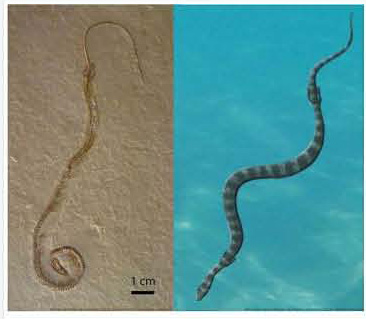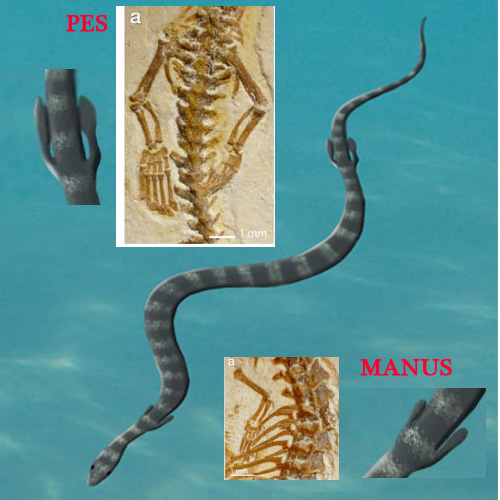Were the Very First Snakes Marine Animals?
New Research on Ancestral Snake Suggests Marine Origins
Scientists from the University of Alberta (Canada), in collaboration with colleagues from the University of Toronto Mississauga, as well as with researchers from a number of academic institutions in Australia, have published a new paper on the primordial fossil snake Tetrapodophis (Tetrapodophis amplectus). This twenty-centimetre-long, Lower Cretaceous snake from Brazil has attracted much controversy, but when described last year, it was thought that this animal was a burrower. However, in this new study published in the journal “Cretaceous Research”, an aquatic lifestyle is proposed. This suggests that snakes evolved their limbless, eel-like bodies for swimming not for burrowing.
Tetrapodophis Fossil Material (left) Compared with the Marine Animal Illustration (right)
Picture credit: University of Alberta and illustration credit to Alessandro Palci and Michael Lee (Flinders University & South Australian Museum)
A Controversial Fossil Find
The tiny snake fossil is preserved in articulation and it has small, but clearly defined limbs, indicating that Tetrapodophis was descended from lizards but was, most likely, a transitional form towards true snakes. Dubbed the “Archaeopteryx of snakes”, after the famous Solnhofen fossils, the specimen has attracted a great deal of controversy ever since it was spotted by Dr David Martill (University of Portsmouth), whilst taking a party of year three students on a tour of the world-renowned Bürgermeister-Müller-Museum (Solnhofen), to view the Upper Jurassic fossils including Archaeopteryx specimens.
To read about the discovery of Tetrapodophis: First Fossil Snake with Four Limbs Described.
The Australian/Canadian team included Michael Lee and Alessandro Palci (Flinders University and South Australian Museum) along with Michael Caldwell (University of Alberta) and Robert Reisz (University of Toronto Mississauga), looked again at the body shape and four limbs of the primitive snake fossil, which probably originated from the Crato Formation of north-eastern Brazil. They agreed with the earlier research, that the limbs were probably too small to be used for locomotion, but they have challenged the idea that Tetrapodophis was a worm-like burrower and that the first true snakes evolved underground.
Tetrapodophis amplectus
This new study suggests that Tetrapodophis had the wrong body shape for digging, the tail is too long and the legs too delicate. The scientists list a series of adaptations that suggest an aquatic animal, adaptations such as wrist and ankle elements made of cartilage rather than bone and poorly developed limb joints, anatomical features that suggest living in water where buoyancy would help to support the animal. Similar adaptations are found in extant marine animals such as seals, sea snakes and sea turtles as well as within the fossil record of the Mosasauridae (members of the Order Squamata that were aquatic).
In addition, the researchers conclude that the hands and feet were surprisingly flipper-like, with a robust and thickened first digit strengthening the leading edge of the limb, like the leading edge of an aeroplane wing or the flipper of a turtle.
Tetrapodophis Fossil Material with a Focus on the Limbs
Picture credit: Alessandro Palci and Michael Lee (Flinders University & South Australian Museum with fossil material images supplied by Science Journal and additional annotation by Everything Dinosaur
Marine Adaptations
The picture above shows the Flinders University & South Australian Museum illustration of T. amplectus as an aquatic animal. The fossil bones represent the pes (foot) and the manus (hand), the limbs of the illustration have been enlarged to show that this new scientific paper suggests marine adaptations including limbs that were paddle-like.
Professor Caldwell (University of Alberta) explained:
“The specimen is of a very small animal, slim, slender, certainly not a burrowing animal, that shows clear features shared with non-snake aquatic lizards from the Upper Cretaceous. Tetrapodophis might well be a member of a group closely related to snakes amongst lizards, but it is not a snake proper.”
A Controversial Specimen
Known only from this one specimen, Tetrapodophis remains controversial. The fossil most probably represents a juvenile, ontogenic changes as the animal grew might cloud any interpretations of the fossil material. In addition, ownership of the fossil is unclear, it had been loaned from a private collection for display in Germany, but it has been illegal to export such fossils from Brazil for many years, and the specimen may be repatriated to the Brazilian Government. The current status of the fossil may hamper access, so that further research is restricted.
To view models and replicas of prehistoric animals: Prehistoric Animal Models and Figures.
Everything Dinosaur acknowledges the help of the University of Alberta in the compiling of this article, the scientific paper is:
“Aquatic adaptations in the four limbs of the snake-like reptile Tetrapodophis from the Lower Cretaceous of Brazil.”
Visit Everything Dinosaur’s website: Everything Dinosaur.



